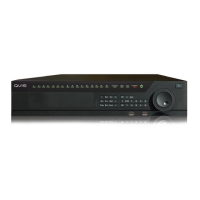
Do you have a question about the Qvis IAPOLLO HDRT HD and is the answer not in the manual?
| Recording Resolution | Up to 1080p |
|---|---|
| Hard Drive Capacity | Up to 6TB |
| Recording Mode | Continuous, Motion Detection, Schedule |
| Operating System | Embedded Linux |
| Video Output | 1CH HDMI, 1CH VGA |
| Hard Drive Support | 1 SATA HDD |
| Compression | H.265 |
| Network Connectivity | Ethernet |
| Mobile Access | iOS, Android |
Safety guidelines for electrical installation, operation, and transportation.
Requirement for qualified personnel, environment conditions, and accessory usage.
Warnings regarding improper use and replacement of lithium batteries.
General introduction and detailed list of key features of the DVR series.
Technical specifications for HDRT HD, Prolite, and PRODC models.
Specific technical details for the iApollo HDRT HD model.
Specific technical details for the iApollo Prolite model.
Specific technical details for the iApollo PRODC model.
Explanation of the controls and indicators on the DVR's front panel.
Detailed front panel overview for iApollo HDRT HD.
Detailed front panel overview for iApollo PROLITE.
Detailed front panel overview for iApollo PRODC.
Identification and function of all ports on the DVR's rear panel.
Detailed rear panel overview for iApollo HDRT HD.
Detailed rear panel overview for iApollo PROLITE.
Detailed rear panel overview for iApollo PRODC.
Visual guides illustrating how to connect the DVR to various devices.
Connection example for iApollo HDRT HD.
Another connection example for iApollo HDRT HD.
Connection example for iApollo PRODC.
Description of the buttons and operations of the remote control.
How to use the mouse and virtual keyboard for navigation and input.
Verifying the DVR, accessories, and checking for damage upon receipt.
Step-by-step instructions for installing hard drives in different DVR models.
HDD installation for iApollo HDRT HD models.
HDD installation for iApollo PROLITE models.
HDD installation for iApollo PRODC models.
Correct procedure for connecting the DVR to its power source.
Connecting video and audio input/output devices and bidirectional audio.
How to connect video sources to the DVR.
How to connect monitors or displays to the DVR.
Connecting audio input, output, and bidirectional audio.
Connecting alarm input and output devices to the DVR.
Specifics on alarm ports for HDRT HD, Prolite, and PRODC models.
Setting up and connecting alarm input ports.
Details on alarm output ports and relay specifications.
Connecting and using the RS232 port for control and communication.
Connecting PTZ devices via the RS485 interface.
Hierarchical overview of the DVR's main menu options.
How to navigate and interact with the main menu icons.
Configuration options for general, encode, network, and other system parameters.
Configuring system time, date format, language, and HDD full behavior.
Adjusting video/audio encoding, resolution, frame rate, and quality.
Setting up recording schedules for different event types and times.
Setting up IP address, subnet mask, gateway, and ports for network connectivity.
Configuring alarm events, activation, and notifications.
Setting up motion detection, video loss, and camera masking.
Setting up PTZ control parameters like protocol and baud rate.
Adjusting display parameters like transparency, channel names, and resolution.
Restoring factory default settings for various system modules.
How to search for recorded video and event data.
Advanced features like HDD management, abnormality alerts, and account settings.
Managing hard disk drives, including settings and grouping.
Managing user accounts, groups, and permissions.
Backing up and exporting system configuration files.
Viewing system information like HDD status, logs, and version.
Displaying details about installed hard disk drives.
Accessing and analyzing system event and operation logs.
How to properly log out, restart, or shut down the DVR.
Steps to ensure a proper network connection before web access.
Logging into the DVR's web interface using a browser.
Navigating and using the DVR interface via LAN connection.
Accessing live video feeds and basic controls in LAN mode.
Playing back recordings and managing channel views.
Using digital zoom, local recording, snapshot, and audio controls.
Operating PTZ cameras through the web interface.
Adjusting image parameters and configuring relay outputs.
Modifying brightness, contrast, hue, and saturation.
Accessing the DVR remotely via a Wide Area Network.
Configuring various system and network parameters through the web interface.
Adjusting channel properties like period, hue, and brightness.
Setting up IP addresses, subnet masks, and network ports.
Configuring event detection like motion, video loss, and camera masking.
Setting up motion detection parameters and zones.
Setting up scheduled recording and storage options.
General system settings, date/time, and holiday configuration.
Basic system configurations including device ID and language.
Configuring system time, date format, and NTP synchronization.
Advanced configurations like text overlay and network types.
Overlaying text information like card numbers on video streams.
Viewing system version, logs, and online user information.
Accessing and analyzing system event and operation logs.
Searching for recorded files and playing them back.
Setting up device alarm types and sound notifications.
Steps to log out of the web interface.
Instructions for removing the web control software.
Troubleshooting common problems with DVR booting and unexpected shutdowns.
Solutions for detecting hard disks, video distortion, and audio problems.
Troubleshooting PTZ control, motion detection, and remote access issues.
Addressing network connection instability, backup errors, and alarm function issues.
Troubleshooting playback errors, forgotten passwords, and remote operation problems.
Lists of compatible USB drives, SD cards, and SATA HDDs.
Formulas and guidance for calculating required HDD storage capacity.
Information on hazardous materials or elements in the product components.